Westminster Cathedral Magazine
We honour St Edward the Confessor as a Patron of Westminster Diocese and a Particular Patron of this City of Westminster; St Edward, pray for us.


We honour St Edward the Confessor as a Patron of Westminster Diocese and a Particular Patron of this City of Westminster; St Edward, pray for us.


Although we earn income from the advertising which we carry, Oremus relies on donations from readers to cover its production costs.
The Companions of Oremus was established to recognise those who give generously to support us. Open exclusively to individuals, Companions’ names are published in the magazine each month (see page 7). All members are invited to one or more social events during the year and Mass is offered for their intentions from time to time.
If you would like to support us by joining the Companions, please write to Oremus, Cathedral Clergy House, 42 Francis Street, London SW1P 1QW or email oremuscomps@rcdow.org.uk with your contact details, including postcode. Members are asked to give a minimum of £100 annually. Please mention how you would like your name to appear in our membership list and if you are eligible to Gift Aid your donation. Postal subscriptions to Oremus may be purchased by completing and sending to the office the coupon printed in the magazine. Subscriptions to receive Oremus either by email (free) or as hard copy by post (p & p payable) can also be entered by visiting https://westminstercathedral.org.uk/the-cathedral-community/about-oremus/ and completing the form there.
Thank you for your support.


Cathedral Clergy House
42 Francis Street
London SW1P 1QW
T 020 7798 9055
E oremus@westminstercathedral.org.uk

W www.westminstercathedral.org.uk
Oremus, the magazine of Westminster Cathedral, reflects the life of the Cathedral and the lives of those who make it a place of faith in central London. If you think that you would like to contribute an article or an item of news, please contact the Editor.

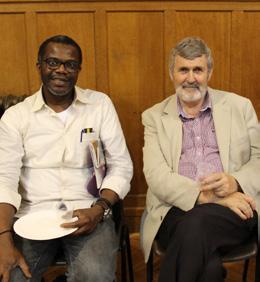
Patron
The Cardinal Archbishop of Westminster Chairman

Fr Sławomir Witon´
Editor
Fr John Scott
Oremus Team
Tony Banks – Distribution
Marie Carne – Content Compilation
Ellen Gomes – Archives
Zoe Goodway – Marketing & Finance
Paul Moynihan – Proofreading
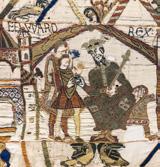
Manel Silva – Subscriptions
Design and Art Direction
Julian Game
Registered Charity Number 233699
ISSN 1366-7203
Opinions expressed by contributors do not necessarily represent the views of the Editor or the Oremus Team. Neither are they the official views of Westminster Cathedral. The Editor reserves the right to edit all contributions. Publication of advertisements does not imply any form of recommendation or endorsement. Unless otherwise stated, photographs are published under a creative commons or similar licence. Every effort is made to credit all images. No part of this publication may be reproduced without permission.


When I was installed as a member of the Cathedral Chapter on 4 December 2012 there was a sense of my life coming full circle. My first appointment as a priest in 1994 had been as a Chaplain of Westminster Cathedral. The rest of my year group were appointed assistant priests in ordinary parishes and my appointment was rather daunting, especially as the Cathedral was about to celebrate its Centenary.
I sought advice from Bishop Pat O’Donoghue, who had been my Rector in Allen Hall Seminary as well as both Sub-Administrator and Administrator of the Cathedral. I was also the first priest he ordained. One piece of advice proved invaluable: ‘In a parish your main community are the parishioners. In the Cathedral, although there are many people supporting its life and mission, your main community are the Chaplains. You must invest time in that community.’ The then Administrator, Mgr George Stack often commented that the priests of the Cathedral had more of a shared life of prayer, work and fraternity than many religious communities!
At that time there were 11 priestChaplains, three resident retired priests and two Daughters of Charity (Sr Anna Teresa and Sr Bridget). In my first year we had 23 catechumens and candidates in the RCIA group, I spent six hours a week in the confessional, was taught by the Assistant Master of Music to sing Mass with the amazing choir, spent three half-days a week carrying the pager to respond to callers at the door and spent a few hours in The Passage every Friday morning. It was an amazing experience and I ended up as Sub-Administrator when the support of the wise and hard working College of Chaplains was invaluable.
The Cathedral also serves as a parish church with people living in the social and private housing between the Cathedral
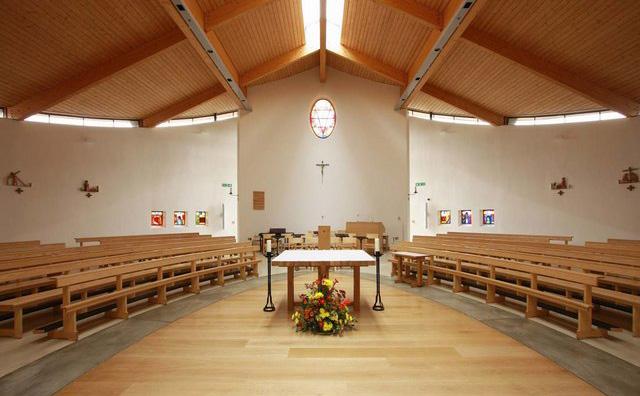
and the river. Many people only see the Cathedral on great occasions and yet the housebound and care homes are visited, chaplaincy provided to the primary school and children catechised just as in every other parish.
When I returned as a member of the Chapter the worship and mission of the Cathedral was as impressive, but with a much smaller College of Chaplains. The Chapter Statutes state that The Chapter should always hold the Cathedral in high esteem and do what it can, both corporately and individually, to support it. Once more, I have had the opportunity to experience and support the incredible work that goes on in our Mother Church. I bring my experience as a teacher, Parish Priest in Islington, Palmers Green and Potters Bar, 29 years working with the Deaf Service and a sabbatical working in Port Elizabeth Diocese in South Africa. The Chapter consists of 18 priests of the diocese with very diverse experience and personalities. I didn’t know many of them very well but, over the past 11 years, I have come to know and appreciate the many gifts that they bring to our fraternity. In 2021 I was elected Provost, which was another daunting experience, but again, I have received a great deal of support and encouragement.
The Cathedral Chapter in our diocese also serves as the College of Consultors. As well as a small number of canonical matters, the Archbishop can consult with the Chapter whenever he chooses. We also meet regularly with the Moderator of the Curia and Chief Operating Officer to receive information and comment on various matters concerning diocesan administration.
When I first visited Westminster Cathedral as a teenager in the 1970s it was in a back street (no piazza!) and my main impression was of a gloomy and dusty place. Since then it has opened up, both physically and in its mission, to be a beacon in the city. So much so that, when the Centenary Appeal was launched for 1995, many of the donations came from companies with offices in the area who cited the service given to their employees by the Cathedral. As a bell ringer I was proud to be involved in the ‘Baptism and Chrismation’ of Big Edward, the bell in the Campanile, when it was fitted with a automatic chiming mechanism as a result of one such donation in 1997. It is a great privilege to be involved with the Cathedral once more and to pray regularly for its mission as a place of prayer, free for all to enter, for which we should be very proud.
The Provost of the Cathedral Chapter is keen to foster the relationship between the Canons, the Chaplains and the wider congregation, so I took the opportunity to ask him whether the members of the Chapter would be willing, in turn, to write a page for Oremus about themselves and their ministries in the diocese. Canon Shaun agreed, on their behalf, and has set the ball rolling himself this month. Happily, the October Chapter meeting sees the Installation of two new Canons, Frs Kevin Jordan and Jeremy Trood, and we can look forward to hearing from them in due course.
In the history of the English Church, Cardinal Wolsey is not necessarily the character of whom we can be most proud, but the world, or least his home town of Ipswich, seems to think differently and is celebrating 550 years since his birth with a series of events and exhibitions (see page 7); my interest is piqued by this and a day trip to what is reckoned to be a historic and lively waterfront town is called for.
Sadly, one inaccessible venue is the closed Holy Rosary church on the edge of a council estate in Oldham. Externally undistinguished, the building is home to a remarkable crucifixion artwork created by a Hungarian jewish artist who came to this country at the beginning of World War II – a reminder of some of the benefits of welcoming refugees.
In the 1980s part of the work was, misguidedly we may think, painted out, but recent tests show that the original work is largely intact under the paint. Now the crucifixion has been listed; more detail is on pages 8 and 9.
Having introduced Philip Hodges (Chorister 1916 – 1921) last month, we can now get into the meat of his memoir. What has struck me immediately is the difference of relationship between choristers and chaplains then and now. When chaplains also taught the choristers, the boys were afforded ample opportunity to observe – and exploit – clerical foibles. Nowadays, we hear the boys all the time, in the Cathedral and the Choir School playground, but have little contact beyond that, so that our eccentricities are perhaps less noticed (see pages 16 and 17).
Among the events of October, the Solemnity of St Edward the Confessor stands out, and not only because it falls on a Friday this year and gives us, in the City of Westminster, a day off Friday abstinence. Westminster Abbey now makes much of the saint’s feast (Edwardtide, they term it) and the customary invitation to shared Evening Prayer (5pm on Thursday 12 October) has been extended. Please come if you can, and take the opportunity to venerate at St Edward’s Shrine.
Westminster Cathedral

Cathedral Clergy House
42 Francis Street
London SW1P 1QW
Telephone 020 7798 9055
Email chreception@rcdow.org.uk
www.westminstercathedral.org.uk
Cathedral Chaplains
Fr Sławomir Witon´, Administrator
Fr Brian O’Mahony, Sub-Administrator
Fr Michael Donaghy
Fr Hugh MacKenzie
Fr Mike Maguire, Precentor

Fr Vincent Mbu’i SVD
Fr John Scott, Registrar
Also in residence
Franciscan Sisters of Our Lady of Victories: Sr Angelina, Sr Fatima and Sr Jesuina
Music Department
Simon Johnson, Master of Music
Peter Stevens Obl. OSB, Assistant Master of Music
Chris Too, Organ Scholar
Cathedral Manager
Peter McNulty
Estates Manager
Neil Fairbairn
Finance Manager
Algernon Keuneman
Fundraising Manager
Laura Dudhee (Maternity cover)
Chapel of Ease
Sacred Heart Church
Horseferry Road SW1P 2EF
As some readers will undoubtedly be aware, Westminster Cathedral has undertaken a major project of updating its lighting. We have updated the lighting in the nave, main sanctuary, choir apse, and three of the side chapels (the Lady Chapel, Blessed Sacrament Chapel, and Sacred Heart Chapel) and we are extremely grateful to all those who have supported this project so far.
Due to rapidly increasing energy costs over the past year the new lighting became a priority project for the Cathedral. The previous provision was also significantly outdated and needed to comply with health and safety requirements. Practicalities aside, the new lighting scheme has also illuminated and enhanced the sacred artwork in the Cathedral, thereby helping to lift visitors’ hearts and minds to God.
Bruce Kirk, the specialist lighting consultant, who led the project, explained how the ‘recent lighting improvements have added a further dimension to the Cathedral’s interior through a number of additions and alterations’. For instance, he mentioned how the new lighting on the sanctuary ‘has provided greatly improved visibility of the celebrant at the High Altar, as well as those leading worship’ and adds that there is ‘new highlighting to both the front and rear of the Rood, and to the Tympanum’.
He also mentioned that in the Lady Chapel, the Blessed Sacrament Chapel and the Sacred Heart Chapel, the spotlighting has also been replaced and dimmable controls added, the latter being an especially useful feature for the Blessed Sacrament Chapel when it is used for the exposition of the Blessed Sacrament on weekdays.
Mr Kirk added that ‘seeing the mosaics of the chapels lit with the pendants dimmed down to low level is both dramatic and atmospheric’ and the ‘new lighting allows most parts of the Cathedral interior to be seen in ways not previously possible’ thus improving the prayerfulness of the Cathedral, be it in the form of meditating upon the sacred art or reading prayer books and guidebooks.
‘Replacing the older spotlighting has significantly reduced energy consumption and also allowed the removal of some unsightly and awkwardly positioned fittings and lighting frames which, in themselves had been identified as health and safety risks. The control system has been extended to include all of the nave and sanctuary chandeliers which now have dimmable lamps fitted. Combining this with the dimmable spotlighting gives endless flexibility for more dramatic and impactful scene setting as well as scope for significant energy saving.’
Furthermore, all of this new lighting is now controllable from a single point or an iPad. This has given the Cathedral a level of control over the lights of which we could previously only have dreamed. This means there is no longer any need to hire in lighting control equipment for Cathedral events such as the Christmas Celebration.
Fr Sławomir Witon´, Cathedral Administrator, said he is: ‘absolutely delighted with the new LED lighting! It not only helps, in a very subtle way, to bring to light the unique artistic architectural features of this magnificent building, it also has a very positive impact on improving the prayerful aspect our Cathedral. As somebody whose eyesight is not the best, having the Cathedral that bit brighter during liturgies makes participation in, and celebration of, the liturgies so much easier for both the faithful and the clergy’.
He added: ‘The new LED scheme is a very big step in our ongoing efforts to reduce our running costs and carbon emissions. It is my hope and prayer that the new lighting will make the Cathedral even more welcoming to the faithful and to visitors, and will aid our efforts to announce the love and mercy of God with confidence to all who come into this sacred place’.
The Friends of Westminster Cathedral have been most generous in helping us raise the funds for the lighting in the Sanctuary. Joe Allen, Co-ordinator of The Friends, said: ‘raising the funds for this lighting update has been a collective effort and a marathon not a sprint,’ and we are very grateful for other significant donors who have made this project possible. These include Sir Harold Hood’s Charitable Trust, the American Friends of Westminster Cathedral, and the many parishioners and private individuals who have been so strong in their support of the work.

To find out more or to help towards the completion of the lighting scheme, please email Laura Dudhee, the Cathedral Fundraising Manager, at cathedralgiving@ rcdow.org.uk or call 07596 855 460.
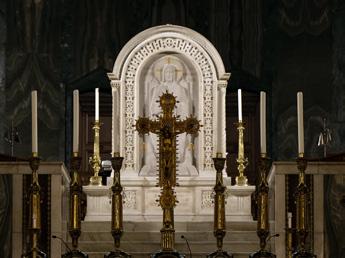
Ipswich is celebrating 550 years since the birth of Cardinal Wolsey in the town. A pilgrimage walk, organised by the ecumenical Guild of Our Lady of Grace, follows a route which Wolsey first inaugurated. Pilgrims can start from St Peter's Church of England Church on the Quay and proceed to the Shrine of Our Lady of Grace in St-Mary-at-the-Elms via Lady Lane, the shrine's original location.
The Shrine of Our Lady of Grace at Ipswich was first mentioned in 1152 and was for centuries a popular pilgrim destination, said to be second to Walsingham. In 1297, Princess Elizabeth, daughter of Edward I, married the Count of Holland in the shrine. Between 1517 and 1522, Henry VIII and Catherine of Aragon paid separate visits to the shrine, as did St Thomas More and Cardinal Wolsey.
Born in Ipswich in 1473, the son of a butcher, Cardinal Wolsey, became a very influential figure in the Church and in King Henry VIII's court as the King's almoner. Between 1526 and 1528, he returned to Ipswich to establish the Cardinal's College of the Blessed Virgin Mary. He planned a procession from his College to the Shrine, which took place in September 1528.
Wolsey fell from grace and was arrested for treason when he failed to obtain an annulment of the marriage of the King to Catherine of Aragon in 1530. He died in that year, on the journey to London and is reported to have said: ‘..if I had served God as diligently as I have done the King, he would not have given me over in my grey hairs’. Wolsey's college was dismantled, the shrine was destroyed and its famous statue was taken on 20 September 1538 to Chelsea to be burnt. The site of the original shrine is marked by a plaque in Lady Lane, a short distance from St Mary Elms.
The pilgrimage walk was reinstated on September 1978, exactly 450 years after Wolsey's first procession and has taken place every year since. The Thomas Wolsey 550 project, (https://www.thomaswolsey550.co.uk), which began in March 2023, features various events to commemorate Wolsey's life and contribution to Ipswich. A highlight this year is the 'Wolsey's Ipswich' exhibition at The Hold, which runs until October 29. Among the exhibits is Wolsey's cardinal's hat, borrowed from Christ Church, Oxford.

We are very grateful for the support of the following:
Lally Ambatali
Mrs Mary Barsh in memoriam
Dr Stuart Blackie
Anne Veronica Bond
Lolita Botanes
Richard Bremer
Lorenzo Cabrelli
Ms Virginia Pinto Cassama
Mrs Erlinda Chin
Francis George Clark
R & L Collyer-Hamlin
Daniel Crowley
Angelita Caronan Duran
Ms Georgina Enang
Wendy Felstead
Alfredo Fernandez
Fred Gardiner
William Gardner-Hunter
Connie Gibbes
Zoe & Nick Goodway
Rosalinda Grimaldo
Mrs Valerie Hamblen
Bernadette Hau
Mrs Cliona Howell
Carl Stephen Patrick Hunter OBE
Alice M Jones & Jacob F Jones
Poppy K
Rosanne Kay
Mary Thérèse Kelly
David Lawton
Raymund Livesey
Alan Lloyd in memoriam
Clare and John Lusby
Pamela McGrath
Linda McHugh
Christiana Thérèse Macarthy-Woods
Ms Ludivina Mangmang
James Maple
Paul Marsden
Mary Maxwell
Abundia Toledo Munar
Euphrasie Mundele Kilolo
Chris Stewart Munro
Mrs Brigid Murphy
Kate Nealon
Cordelia Onodu
Cris Ragonton
Alan Rainer
Emel Rochat
Berenice Roetheli in memoriam
Clementina Rokosu
Precy Salvador
John Scanlan
Sonja Soper
Tessa and Ben Strickland
Yollie Sumayod
Julia Sutherland
Eileen Terry
Robin Michael Tinsley
Lucila Torrefiel
Mr Alex Walker
Peter W Wilson
and of our anonymous Companions
If you would like to become a Companion of Oremus, see page 2
Following a long campaign led by SAVE Britain's Heritage, the government has added the 'Oldham Mural' masterpiece to its national heritage register - listed at Grade II. Titled 'The Crucifixion', the post-WWII mural was completed in 1955 by Hungarian artist George MayerMarton and was designed for the Church of the Holy Rosary in Oldham. The church, on the edge of the town, is owned by the Diocese of Salford but closed in 2017 leaving the mural vulnerable to decay and vandalism.
The 7.5m long mural depicts the figure of Christ in golds and tans against a dark blue cross and gold mandorla. It was commissioned following the Festival of Britain when public art came to be seen as a symbol of civic renewal and social progress. Sophie Andreae, Vice Chair of the Bishops' Conference Patrimony Committee, said: ‘The Mayer-Marton mural in Oldham's Holy Rosary Church is of great importance. The listing recognises this. The Patrimony Committee looks forward to working with Salford Diocese, and all interested
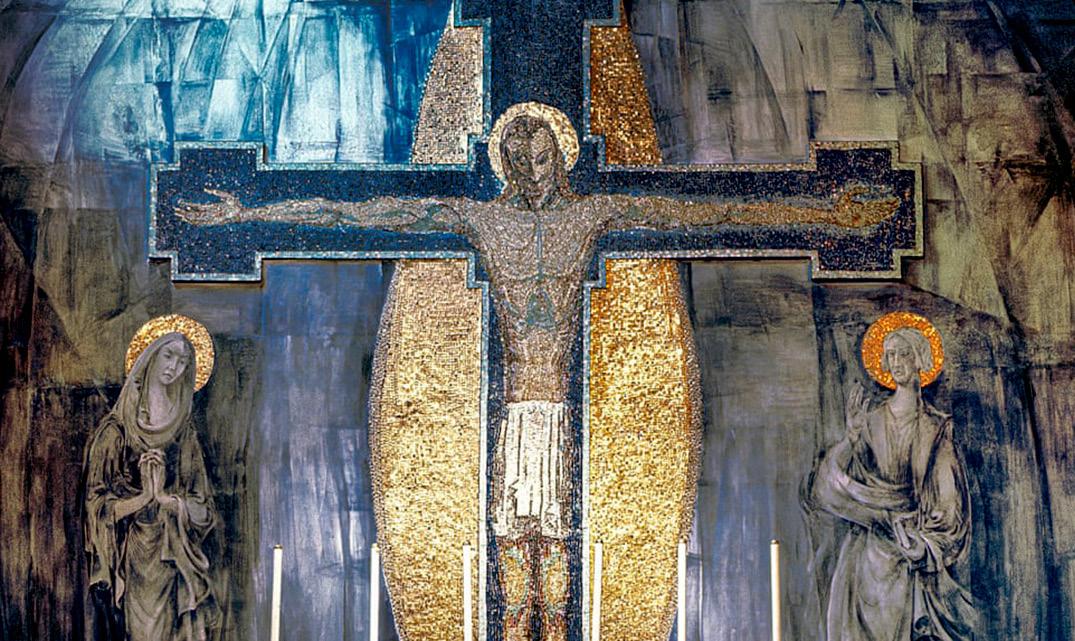
parties, to ensure the protection and proper conservation of this outstanding artwork. This is now urgent’. In 2017, an application to list the mural was rejected as it was thought to no longer be intact as the fresco part of the mural had been painted over and the mosaic haloes of Mary and St John removed. However, over the last five years, tests have shown that the original fresco remains in good condition beneath the paint, which has led to the highly unusual and possibly unique mural being listed.
On the east wall the mosaic of Christ on the Cross stands approximately 7.5m high and 5m across. Christ has the straight-legged pose of Christ Triumphant (Christus Triumphans), often found in C12 and C13 Italian art, though the bowed head is reminiscent of the Suffering Christ (Christus Patiens) of Eastern Christian tradition. The slender body is articulated by the use of many-coloured smalti (small rectangular tiles of handmade opaque glass), his bearded head surrounded by a golden halo of gold-leaf inlaid glass tesserae. The figure is set against a deep
blue cross with the tiles of the cross within a bordering metal frame, and a backdrop of a shimmering golden mandorla (the upright almond shape found chiefly in medieval art enclosing Christ or saints). Historic photographs show the fresco blends the figures of Mary to the left and St John the Apostle to the right with an abstract backdrop of cubist shapes, perhaps representing a landscape or the night sky and heavens darkening as described in the New Testament. The figures have sinuous poses and draperies. The uncovered trial areas show their faces to be intact except where the mosaic haloes have been removed, as is the small, uncovered area of St John’s robes. The original technique used is clearly visible with incised lines cut into the fresh plaster to set out the design and thin transparent paint layers.
The fresco component of the artwork was painted over with off-white emulsion paint during the 1980s. Uncovering trials in 2019, and more extensively in 2021 by Opus Conservation demonstrated that the original fresco remained in good condition
beneath the emulsion layer, a pinkish plaster skim and a blue repaint applied to make the original colour brighter. The integrity of the uncovered areas demonstrated that removal of the applied layers was possible and strongly suggested that the rest of the scheme remains largely intact. It was confirmed that the gold mosaic haloes of Mary and St John the Apostle had been removed prior to the application of the plaster skim.
Mayer-Marton was a Hungarian Jew, born in Gyor in 1897. Settling in Vienna, he became the vice-president of the important and progressive Hagenbund group of artists between the Wars, who had an interest in the unity of architecture and art seen in the British Arts and Crafts movement and the German-Austrian tradition of Gesamtkunstwerk (total work of art linking painting, architecture, word and music). In 1938, following the Anschluss, Mayer-Marton and his wife fled to Britain; the Nazis subsequently destroyed all his pre-war frescoes in Austria and his family, who remained in Hungary, perished in the Holocaust. He worked as a lecturer for the
Council for the Encouragement of Music and the Arts (CEMA), predecessor of the Arts Council until 1952. He was then appointed senior lecturer at the Liverpool College of Art where he established the Department of Mural Art, the first of its kind in Britain. After his appointment, Mayer-Marton received a number of ecclesiastical commissions: a mosaic font for Tettenhall (1955); the Crucifixion mosaic and mural for Holy Rosary (1955); a Pentecost mosaic for the Holy Ghost, Netherton (1957, relocated to Liverpool Metropolitan Cathedral in 1989); and a mosaic of St Clare for the Franciscan Church of St Clare, Blackley (1958). He died in Liverpool in 1960. His artworks are held in collections including the British Museum, the V&A, the Scottish National Gallery, Swansea’s Glynn Vivian Art Gallery, and the Belvedere Gallery in Vienna (Austrian National Gallery), who held a retrospective of his work in 1986.
The new List entry describes the striking aesthetic combination of neoByzantine mosaic and modernist Cubistinfluenced fresco inventively applied to
traditional Christian iconography in a deeply personal evocation of suffering and redemption. Mayer-Marton’s great nephew, Nick Braithwaite, said: ‘I am delighted this masterpiece of exceptional significance is finally receiving the national recognition it deserves. I am grateful to everyone who has helped get us here and especially to SAVE Britain's Heritage for keeping the mural in the spotlight.’ The campaign was also supported by the directors of museums including Tristram Hunt at the Victoria & Albert Museum, who praised the mural's ‘dazzling beauty’, as well as Gabriele Finaldi at the National Gallery in London, László Baán at Budapest's Museum of Fine Arts and Harald Krejci at the Belvedere in Vienna. Henrietta Billings, director of SAVE Britain's Heritage, said: ‘This is a fantastic result for Oldham, and modern public art in England. We're delighted that the mural will now be celebrated and finally given the recognition it deserves. Listing will open up a new chapter for this building and artwork and we look forward to helping the Diocese of Salford to find a new and sympathetic owner’.

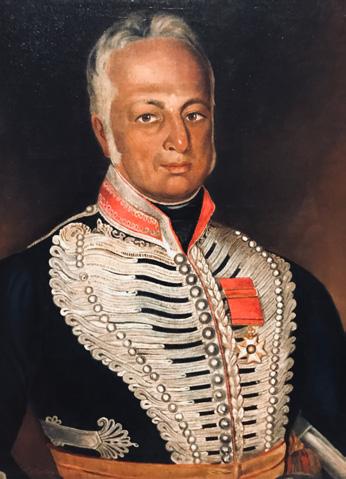
staff make it clear that one should walk on. The reason is probably the front door itself. To be more accurate, it is three double doors in bronze. Setting the tone for the whole building, the doors were created by Tracey Emin, who has depicted 45 women upon them.

The National Portrait Gallery is back in business; and commerce seems to have been prioritised. The shop has grown in space and grandeur, along with everything else. The NPG’s previous incarnation, which I’d always thought of as friendly, is now described as ‘fusty’ by reviewers. The media consensus seems to be that the new space is altogether superior. Both the Telegraph and the Guardian seem to agree on this. Those who believe that substance matters as much as style might not share this view.
Many of the changes that have been made over the past three years of closure seem superficial. The architecture firm in charge is getting as much attention as the curators and the collection. I’ve sometimes wondered what one would say to a valued friend who has just paid a lot of money for some superfluous cosmetic surgery. I can start practising with this old acquaintance.
The location has not changed. It’s still on a leafy corner close to St Martinin-the-Fields and even closer to Nurse Edith Cavell’s striking memorial. The old entrance is still there, although the
There are plenty more women in store. Whether artist or subject, there is an abundance. Nurse Edith’s loss –as the rare female subject of a public sculpture that is now less visible – is the gain of countless women artists. There is a whole new gallery dedicated to them; or is this a temporary situation? Whatever the outcome, the Weston Wing is something new. Apparently this former office space used to be called the East Wing; a change of orientation all round. Throughout the building there are more works by women artists and of women subjects. Somewhere I saw a statistic of 50% parity mentioned.
With the massive number of photographs and paintings on view, it’s easy to overlook some. One of the most enormous and inescapable is a reminder of the olden days at the NPG. It’s a portrait of Queen Elizabeth with the Duke of Edinburgh. The image was captured in 2011 by the German supersizing superstar Thomas Struth. There are no gimmicks about it. There aren’t even any corgis. The sitters are just an elderly, simply dressed couple surrounded by older and more opulent furnishings. It provided a first-rate view of their footwear.
There’s plenty of fun stuff on view too, along with a wall called “A Creative Constellation: Contemporary Women in the Arts”. The theme is portraits of women by women photographers. It might not be quite the size of a real constellation, but entertainment is afforded in trying to work out who the
subjects might be. There’s no mystery about who financed this initiative. The largest font on the info panel mentions CHANEL Culture Fund. Is this a cross-museum teaser for the V&A’s blockbuster on Coco Chanel, due to open on 16 September?
The next gallery space offers faces that are not necessarily any easier to identify despite the names being more famous than some of the stars in the Creative Constellation. On view are plaster casts made from the death masks of luminaries such as Francis Bacon (artist) and Oliver Cromwell (despoiler of Ireland). The latter might have merited an advisory notice in some museums – such as the triggerwarning-happy Tate Modern – but the NPG has not gone quite as contemporary as some visitors have suggested.
At this point in my tour of the revamped premises, I realised that I was drifting. Perhaps this is the management’s intention: a Brownian Motion adventure
of chance encounters. The normal routine would have been a quick ascent to the Tudor enclosure on the top floor. However, doing my duty as an inspector of the remodelled museum, I sought the comfort of the old lavatories. They are indeed in the same place as before. There have been modifications, though. The NPG has gone gender neutral, and with it any vestiges of the patriarchy. In principle, this is perhaps a good way of showing the chaps how lucky they’ve been. In practice, it leaves one wondering why the grand renovation couldn’t have expanded the quota of lavatories for everyone.
After this experience, the revamped Tudors could hardly faze anyone. Despite some tinkering with the space, it’s still the most atmospheric part of the NPG. Gorgeously subdued lighting and paintings so vibrant they pop off their wooden panels continue to thrill. It’s conspicuous how much more crowded this section is than, for example, Victorian worthies on the floors below. The subject matter is so much more alluring, and for followers of religious politics it’s irresistible. The curators and display team seem to have grasped this. The beatific St Thomas More is facing off against the Earl of Essex, better known as Thomas Cromwell. How convenient that they – or Hans Holbein – chose opposite profiles. This is, of course, a very rare portrait of Hilary Mantel’s hero, copied later for Cromwell’s descendants. St Thomas, on the other hand, can be seen surrounded by his family in a huge group portrait that greets visitors on their way in to the Tudor gallery. It’s a shame that there’s no equivalent for the Cromwells, especially after Hilary Mantel brought them all so lovingly to life in her trilogy.
Far more numerous than the two Thomases are portraits of Queen Elizabeth I. Good Queen Bess was, like Cromwell, something of a loner when it came to portraits. Unlike her father’s chief henchman, she really dressed for the occasion. Nothing in the NPG can match the splendour of her raiment and accompanying jewellery. Having inspected all of these images, I can confirm that she was rigorous on the wearing of crucifixes. Although she was partial to them on altars, no Papist accessories were allowed in her portraits. The closest substitute is the Pelican in Her Piety.
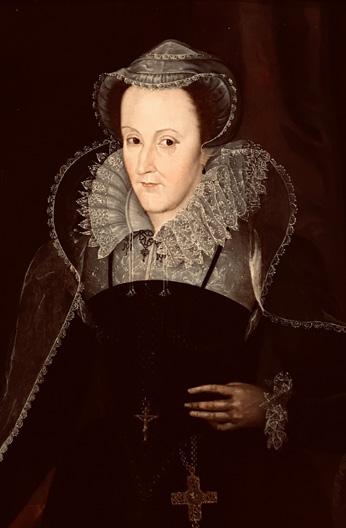
Any Catholic visitors who want to see Christ in Tudor jewellery will find His image around the necks of Mary Queen of Scots and the More family. To reach this splendidly visual introduction to the Tudor era, the escalator is still available. Something has changed with it, and I’m not quite sure what. It might be that it is more enclosed than before. Maybe the previous exposure was too much for vertigo sufferers to endure before they had even reached the best bit of the NPG. Another novelty is the Anthony Gormley sculpture positioned near the top of the escalator. As it is neither Tudor nor a portrait, it’s unclear what this striking work is doing there. It does embody the alienation of the modern age though.
There was portraiture after the Tudors. This was a field in which British artists excelled. Despite the expensive renovation to the building, visitors are still surrounded by the same old faces as previously displayed from the Jacobean, Georgian and later eras. These are reassuring, rather edgy, which is no doubt why the curators have staged an intervention. Instead of a straightforward showing of boring old empire builders, poets and people of consequence, questions are asked about colonialism. A section of the NPG has been turned over to ‘Portraying Colonial Power and Expansion: 1760-1850’.
The analysis is more impartial and well considered than might have been anticipated. There are, of course, references to the prejudices that kept the pulse of the British Empire going, along with a sighting of people I’d heard of but never seen before. ‘Skinner’s Horse’ was a regiment that appears often in the history of India, but I didn’t know much about the patriotic but poorly treated Lt-Col James Skinner. There’s a splendid portrait of the man behind the horse (on loan from the British Library). The NPG has also squeezed in a very contemporary image of that campaigner against French racial oppression, Toussaint L’Ouverture. Lubaina Himid’s powerful work is a useful part of the story that exposes the sham of Napoleon’s fine ideals about egalité.
This section is a rarity in corralling visitors into a political discourse. One could happily drift for days through the rest of the NPG looking more at the faces than the ideologies behind them. How it took so long to change so little is a mystery, and a relief at the same time. Best of all, entry is still free.

A 400-year-old Missal that once belonged to a priest who helped save the life of King Charles II, has gone on public display after being bought for the nation by the National Trust. Fr John Huddleston's (1608 - 1698) personal missal can now be viewed at Moseley Old Hall, near Wolverhampton, the house where he was chaplain when Charles sought refuge after escaping Cromwell's troops following the Battle of Worcester in 1651.
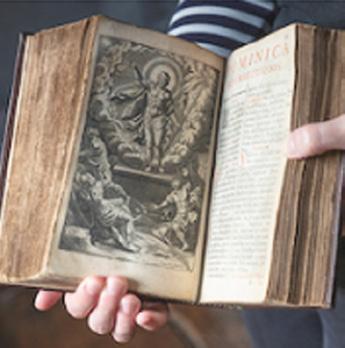

The book, bearing Fr Huddleston's signature, was purchased by the conservation charity at auction thanks to a generous donation from a volunteer and support from the Friends of the National Libraries. The successful bid means this important piece of history has been saved for the nation and has returned to Moseley permanently, some 363 years since it was first there. Published in Paris in 1623, the rare copy of the Missale Romanum was possibly used to convert Charles II to Catholicism on his deathbed. Fr Huddleston was a Benedictine priest who lived at Moseley Old Hall, dressed as a servant, with the Catholic Whitgreave family, who had stayed loyal to the Royalist cause following the execution of Charles I.
Following defeat by the Roundheads at Worcester, Charles fled to Boscobel House in Shropshire, where he hid in an oak tree, before arriving at Moseley Old Hall the following night. Flanked by a small group of supporters, he entered via the studded oak back door, still in place today, and was given shelter. Fr Huddleston helped Charles seek refuge in his first-floor room, which had a view of the approach road as well as an escape route via a back staircase. A priest hole, accessible by a trapdoor beneath the floor of a cupboard, provided a hiding space for Charles when armed soldiers turned up at the house. The 'King's Bed', on which Charles managed to get some sleep, fully clothed, also remains in the hall today.
The King is understood to have consulted books in Huddleston's library and it is likely that the missal – now complete with evocative drops of candle wax on some pages – would have been one of them. Following nine years of exile and the restoration of the Monarchy in 1660, Charles made Huddleston chaplain to his Catholic mother, Queen Henrietta Maria, and later to his Catholic Portuguese wife, Catherine of Braganza. He also summoned Fr Huddleston to his bedside at Whitehall Palace in London in 1685, as he lay dying. Huddleston heard the king's confession, administered the Blessed Sacrament and received him into the Catholic Church. The Duke of York is believed to have said that Huddleston saved the king's life twice: first his body, then his soul.
The Missal joins a collection that includes portraits of Thomas Whitgreave, the owner of the hall at the time, and of Fr Huddleston, as well as a letter King Charles II sent to a young local woman, Jane Lane, thanking her for helping him escape to France. Sarah Kay, Cultural Heritage Curator, said: ‘We're delighted to have secured this important book which is central to the story of Moseley. If we hadn't acquired it, it is likely to have gone into private hands and not been accessible by the public. Displaying and interpreting the missal will provide a compelling focus and renewed impetus for telling the story of Charles II's remarkable escape.
Tim Pye, National Curator, commented: ‘The Huddleston Missal is a wonderful acquisition for Moseley Old Hall. Not only is the 1623 edition of the Missale Romanum a rare book – just one other complete copy is recorded in UK libraries – but it is also crucial for our understanding of how Roman Catholic books were used and circulated at a time when it was dangerous to be anything other than Anglican. The way in which Huddleston has inscribed and annotated his missal highlights just how precious and personal this book would have been to him’. The Missal was previously owned by Joseph J Procter who paid a Liverpool bookshop just sixpence for it, in the late 1950s. Mr Procter's family have visited Moseley Old Hall to view the book and expressed their delight at it now being on public display.
St Vincent de Paul School has six values that we as a community focus on throughout the year. Our special values were created by the children and staff of SVP together and we decided on them about four years ago. These six values have a special link to our Mission Statement, ‘Love one another as I have loved you’.
In this article, I will be writing about them. They are: Respect , Responsibility , Positivity , Generosity , Achievement and Aspiration . Each of these values has its own special and important meaning and I will explain them.
Respect is a feeling of admiration for someone or something elicited by their abilities, qualities or achievements. It’s a way of treating or thinking about someone or something. For example, if you respect a teacher you admire them and treat them well. To show respect you can communicate nicely, treat others the same way you would like to be treated (following in Jesus’ footsteps), listen closely and give your full attention when someone else is speaking. By doing all of these things you are making the other person feel valued and respected. Responsibility is the state or position of being responsible which means doing things you’re supposed to be doing even when no one is watching you. You are responsible for making sure your homework is completed on time or taking care of your pet. Being responsible is also important because it proves that you can be trusted. Responsibility is essential because it provides a sense of purpose and it also builds resilience.
Positivity means smiling to everyone, being cheerful and happy. A positive person is finding joy in everyday moments. For those who are positive the word seems to be a better place. Just like Mother Teresa said: ‘We shall never know all the good that a simple smile can do’. Positivity is infectious, so go and share it with others.
Generosity means giving without expecting something in return. Do you think generous people only give money? No! They can donate money but they can also offer time, love and advice. Instead of buying an expensive gift, maybe make a homemade card and present or show love by spending real time with that person.
The next value is achievement . It is when we are working hard to achieve our goals. To achieve something wonderful we should never give up and even when things are difficult, we need to stay strong and persevere. Even in the darkest moments we should still try to finish what we have started. By working together, we could achieve more than working alone and with the help of God we can achieve anything. Once again, we can link this to our Faith, thinking about all of the accomplishments of St Vincent de Paul when he helped the poor and needy.
The last value I would like to write about is aspiration Aspiration is like an ambitious dream or goal that you really want to achieve. If you put your heart and mind into it, anything can be possible.
I hope that you have enjoyed finding out a little more about St Vincent de Paul Primary School and the values that we have.




Westminster Cathedral was built from 1895 to 1903 in the style of an early Byzantine basilica – constructed and faced with brick and decorated internally with marble and mosaics. The marble work is now effectively complete but only a small part of the Cathedral has yet received its mosaics – 11 of the 12 chapels, the great sanctuary arch and the smaller arch in the crypt, one of the confessional recesses and a few smaller recesses and panels elsewhere. Yet already over 14 million pieces of mosaic have been laid. To complete the decoration in the manner originally intended would require perhaps 100 million.
Mosaic consists of small pieces of marble, stone, terracotta or glass known as tesserae (or smalti in the case of opaque Venetian glass), which are applied (fixed) to a prepared surface. When the practice first began is unclear, but by the third millennium before Christ coloured terracotta cones were being pressed into damp mud to decorate buildings in Mesopotamia (modern-day Iraq), and by the start of the fourth century BC coloured pebbles were being used by the Greeks to produce regular patterns and representations of human figures and animals on floors. The Romans also used mosaic extensively on floors and in the first century BC they began decorating the walls of their natural or artificial rustic grottoes, often containing a water feature such as a spring or fountain, with marble chips, seashells and eventually stone and glass tesserae.
In the first century AD the Roman use of decorative glass on walls increased, though it is only in a few places such as Pompeii and Herculaneum, engulfed in cinders, ash and mud by the eruption of Vesuvius in 79 AD, that these early wall mosaics have been preserved. For when a building collapses the walls fall in, protecting any floor mosaics but shattering those on walls and vaults. It was the mosaicists of Christian Constantinople (previously Byzantium, now Istanbul) and
its empire who mastered the technique of decorating walls and vaults with glittering gold, silver and coloured glass tesserae, during the 1,100 years (330-1453) of Byzantine rule. The early figure mosaics of Constantinople itself were largely destroyed in the period of iconoclasm (726-843) and most of these subsequently restored were plastered over or defaced after the city’s capture by the Ottoman Turks in 1453. Handfuls of tesserae would be given to visitors to Justinian’s great sixth century church of Santa Sophia (Hagia Sophia or Ayasofia) as late as 1840. But early Byzantine mosaics still exist in places such as Ravenna in Italy, Porec in Croatia, and Thessaloniki (Salonica) in Greece, while outstanding examples of later Byzantine mosaics can be found in Istanbul, in Palermo, Monreale and Cefalu in Sicily, in Venice and in Greece. It is these Byzantine mosaics that Westminster Cathedral mosaic designers have usually turned to for inspiration and which they have often attempted to emulate.
The opaque glass used in the Cathedral average one square centimetre in size and are half a centimetre thick. Thus they are about the same size as those used by Byzantine mosaicists in the church of Santa Sophia (now again a mosque) in

Istanbul, and later in St Mark’s Basilica in Venice. They come mainly from Venice and the island of Murano nearby. Some have gold or silver leaf fused onto clear glass with another thin sheet of glass (cartellina) on top to protect the metal from the atmosphere. Normally 500700 tesserae are used to the square foot, depending on their size and proximity, so the blue sanctuary arch mosaic in the Cathedral consists of about a million and the Lady Chapel has about three million. The first Cathedral mosaics were laid in the Chapel of the Holy Souls in June 1902 using the direct method. In this, fullsize coloured drawings (cartoons) of the designs are outlined, pricked or traced onto the working surface. The tesserae are then inserted directly into the fixing medium of adhesive cement, using the cartoon as a guide to their positioning and colour.
The Cathedral architect, John Francis Bentley, was not concerned whether the fixing medium was water or oil-based (which allows more time for adjustment before setting), providing it was durable and the tesserae were worked in situ on the walls. In fact, oil based mastic was used for all the early Cathedral mosaics. The potential advantages of the more traditional, direct method are precision, the glittering effect of gold and silver tesserae inserted individually and thus at different angles to the light (demonstrated spectacularly in the vault

of St Andrew’s Chapel), and the difficulty of judging the effectiveness of a mosaic in terms of colour and proportion when it is produced under a bright light (and possibly upside down) in the studio, rather than in its final position high on a wall or vault and dimly lit from below. In the Cathedral the direct method was used for the Holy Souls Chapel, St Andrew’s Chapel, the Lady Chapel, the Sacred Heart Shrine, the sanctuary arch, the main arch in St Peter’s crypt, the inner crypt panel of St Edmund blessing London, the south

transept confessional recess, the panel of St Joan of Arc in the north transept and the RAMC (Royal Army Medical Corps) memorial in St George’s Chapel.
The direct method is the one used in antiquity, though prefabrication did sometimes occur when working on very detailed panels for insertion (emblemata). One way of doing this is to assemble the tesserae face upwards in a temporary bed of damp sand, etc., then cover them with gauze or similar material pasted with water-soluble gum. Attached to this, the mosaic is lifted from its temporary bed and secured in its final position. The gauze or other material is then soaked and removed. Another method is to cement the tesserae, again face upwards, onto a permanent backing of board or mesh. This is then transferred from the studio and secured in its final position with screws or adhesive cement. The indirect or reverse method, disliked by Bentley, is to assemble the tesserae face downwards onto gummed, full-size cartoons. The tesserae attached to the cartoons (often cut into numbered segments) are then pressed into the permanent fixing medium on the wall or vault, the cartoons subsequently being soaked and removed to reveal the mosaic (now face up), below. The mosaic is then grouted to produce a level surface. In the Cathedral this method was employed for all the mosaics not listed in the previous paragraph except for the panel of St Patrick in the south aisle which was produced by Trevor Caley on board in the studio.
Voice trial
I came from a family of seven children, four girls and three boys. My father was a pharmacist and manager of a sizeable branch of Boots Cash Chemists in Sheffield. He was a deeply conscientious man and committed to long hours of work on behalf of his firm. Each evening he would return to his shop till 8 o’clock in order to complete his paper work. He was a passionate lover of Grand Opera and indulged his taste for Wagner, Verdi and Gounod when the Carl Rosa Company came for a short season to Sheffield. Shakespeare was his other love. He belonged to a group devoted to the Bard and when they put on a Shakespearian piece it was his delight to have a small part. He could quote lines from Hamlet in any given situation at home. I think my mother, who came from a commercial family, regarded his literary qualities with something approaching awe.
An advertisement in the press announced the holding of the annual ‘Voice Trial’ at Westminster Cathedral of prospective choristers. Preference would be given only to candidates of clear musical promise but more especially to the sons of gentlemen who had ‘suffered for the faith.’ This was an era when Roman Catholics were looked upon either as second-rate citizens or even of dubious loyalty to the state. At the time disparagement of Catholics in general was common and an Anglican ‘divine’ once referred to the Roman Church in England as ‘The Italian Mission.’
My mother was the driving force in our domestic scene; it was she who made an application for me to attend this voice trial and proudly took me to Westminster for interview. She was born in London and had several brothers and sisters living there.
In due course I won my scholarship and was accepted on probation as a resident boy-chorister in June 1916 and took up my place there in the following September. Before the interview I had great anxiety lest I should develop a ‘frog-in-the-throat’ and had taken quantities of ‘Meloids,’ microscopic bits of medicated liquorice, in order to lubricate my larynx against the fateful voice test. Arriving at the Choir School my mother and I were escorted to the library. In each of the reading bays were other timorous candidates receiving last minute advice from anxious mothers. Eventually I was ushered by a senior choir boy, stiff in his ‘bum-starver’ Eton Suit into Dr Terry’s office, a tiny box off the main corridor connecting the Clergy House to the Cathedral. Mgr Herbert Hall, rector of the Choir School, was there awaiting me and Terry, like a fat-looking Buddha, sat on a swivel chair before a very untidy roll-topped desk. Having checked my musical background from the application form he swivelled round to a tiny ‘Bord’ piano and asked me to sing the scale of C to the syllable ‘coo.’
Then came the vital ear test, a descending sequence of B-A-G-B reflexed to D. Immediately after this came another descending passage C-A-F sharp-D reflexed to G. He played these notes slowly on the piano and asked me to sing them. Whilst waiting my turn for interview I could not fail to hear the efforts of two other candidates before me doing this crucial test. Their efforts sounded to me like the wail of a caged animal. It should be observed that voice production, correct breathing, musical theory, sight-reading and dynamics can be taught with confidence but what cannot be taught is a musical ‘ear.’ Any defect in this is a total bar to choral singing just as colour blindness is a total bar to a master mariner’s ‘ticket.’ In the first five notes the minor 6th drop of G to B followed by the minor 3rd up to D is fatal to the tone deaf. If one succeeds in this hazard the next five intervals are comparatively easy.
I must have jumped this fence successfully for I was then asked to sing a simple English ditty but the ordeal was not yet over. Terry struck a major triad chord on the piano and asked me to sing the middle note. I scored first go and becoming more confident I asked if I could play ‘God Save the King’ to my own harmony. He laughed at my efforts which put me off a bit but I was then taken into the Choir School where Mgr Hall gave me a very simple test in the 3 R’s. I was ten years old (among the unsuccessful candidates was John C (later Cardinal) Heenan).
It was a hot day in that June of 1916 when the lives of multitudes of soldiers were being squandered in the mud morass of Flanders. Later as my mother and I came out of Charing Cross tube station into the bright sunlight of the Embankment, the news billboards carried the laconic message, ‘Kitchener Drowned.’ Some two weeks later my parents were informed that I had been accepted on probation as a chorister. The total strength of the choir school was 32 boys. I had won a partial scholarship and my father was asked to pay £25 per annum towards my full board, lodging and education. This included intensive instruction in music and was tenable until my voice broke. Given the value of the pound sterling at the time, I can only guess what a sacrifice this was for my parents struggling to educate seven children.
It is interesting to note some of the clothing and other requisites that they were obliged to provide me with. In addition to the usual three of each kind of underwear there were listed two stout pairs of black boots, two ‘Eton’ suits, a clothes brush and, believe it or not, a bowler hat. Realising that this list had been drawn up by some antiquated matron in the distant past, my mother decided to withhold the provision of the bowler hat until I had arrived at the school. How right she was. One or two of the freshmen whose parents had actually bought this improbable headgear for their sons had the pleasure of seeing their bowlers snatched from them
to be kicked around the common room as footballs. In fact we were all provided with a common-sense navy blue cap bearing a badge of the cardinal’s coat-of-arms when we arrived at the school.
My father took me from Sheffield to London that first Saturday in September 1916 to take up my scholarship at the Choir School. It was my first taste of leaving home and being thrust into the company of strange boys the majority of whom were London-born and therefore less liable to home-sickness. I cowered under the bed-clothes in the dormitory that first night until a dull strange light in the sky and the distant sound of gun-fire brought us all to the windows – a raiding Zeppelin had caught fire and was to come down at Potters Bar. The next day, Sunday, my father came down from Hampstead to see me walk in procession to the Capitular High Mass in the cathedral. He was obviously shaken by the Zeppelin raid. We had a brief reunion and a final embarrassing parting, for he was a shy man.

Westminster Cathedral Choir School is part of a complex of buildings situated beyond the apse of the Cathedral. Archbishop’s House, the Clergy House and the Choir School are so close to one another and indeed, laminated in places so as to make almost one building. They are served by a common corridor leading to the sacristy of the Cathedral. The roof of this corridor provided a private walk for the cardinal who often said his ‘office’ walking with measured tread up and down this dull esplanade, overlooked by the private rooms of the clergy and the upper rooms of the Choir School.
The rector of the school and his assistant were both priests of the College of Chaplains attached to the cathedral but, as such, they were relived of any pastoral duties. A Miss Newnham came daily to teach us probationers but all the other masters were priests domiciled in the clergy house who, in addition, had normal pastoral duties to perform.
One of them, Fr Joseph Collings, a brusque, healthy, sufferme-no-fools, was a sergeant major type. He divided his time between the Archbishop’s House secretariat and the choir school
as teacher of French for he had been educated in France. In class he would refer to the Cardinal as ‘my lord and master.’ He was merciless if your work was not up to standard and if you presented a French exercise with faulty syntax you received a piece of foolscap coloured bright blue on which to re-write it. Any attempt to do this imposition during the one and a half hours evening ‘prep’ would immediately be spotted by a supervising master who would tear it up. Failure to return a ‘blue-paper’ merited a visit to the disciplinarian for, say, ‘three on each hand.’ I was no saint but did my best to keep just within the law; I suppose I received this punishment about three times during my years in the Choir School.
Fr Collings, like most supermen, had a weak spot which we soon discovered and traded upon. It was surgery. He had an almost insatiable interest in the goings-on in an operating theatre. He had a friend, a Mr Shattock, a consultant surgeon, who allowed him to don a theatre mask and gown and witness at close hand several abdominal operations. He was present at the appendectomy performed on Dom Gregory Murray, then a chorister at the school and, by repute, he had the appendix suitably preserved in a bottle. During a dull spell of the conjugation of irregular French verbs in class a boy would casually mention some ailment which required major surgery. Collings would fall easily for this red herring and draw on the board the alimentary canal in all its ramifications as far as the rectum. Thus half a French lesson would be dissipated in the ghoulish description of where the scalpel was applied and what happened afterwards – but it was sometimes a happy relief from the boredom of French unseens.
He would intermingle his teaching with sour observations on mankind in general and declared his hand as a confirmed misogynist. He could not put up with the foibles of womankind, including those of his mother or the irritating behaviour of an order of nuns to whom he was assigned as a visiting chaplain. If a woman spoke to a bishop at a social function, she was ‘obviously coquetting with him’.
The demolition of the former House of Fraser Department store on Victoria Street (is the Editor the only person to have noticed how rarely there ever seemed to be anyone shopping in it?) allows an enhanced view of the fine period buildings on Artillery Row. Doubtless the view will disappear again when another new glass and steel structure arises, so let us make the most of this temporary respite.
The Administrator and the Cathedral Architect were pleased to welcome to the Cathedral Dr David Hoyle, the Dean of Westminster Abbey, for a comprehensive tour; and where better to start than by St Peter, who is, of course, the Abbey’s Patron.

So much of Victoria Street and its environs now seems to have been built with a lifespan of not more than 50 years in mind, so it is reassuring to see the top of the Cathedral tower standing out, with a relic of the Holy Cross encased in it to witness to Christ’s reign over and care for all.
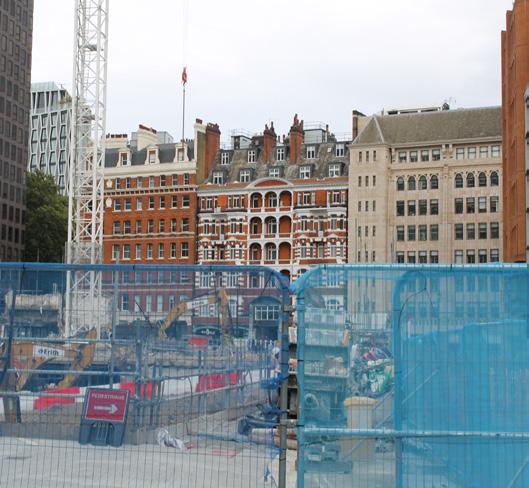


Scripture tells us that the Lord loves a cheerful giver and here we see cheerful Cathedral volunteers taking their well-deserved break from usual duties. It looks like a good crowd, but not all were able to be present; and there are always more volunteering opportunities
The annual Mass of Thanksgiving for Cathedral Volunteers was followed by the traditional party in Cathedral Hall. Refreshments aside, this was a good opportunity to meet other volunteers and discover the whole range of activities undertaken in support of the Church’s mission.
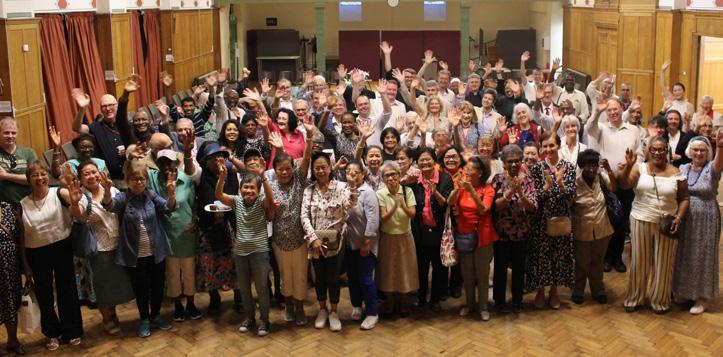

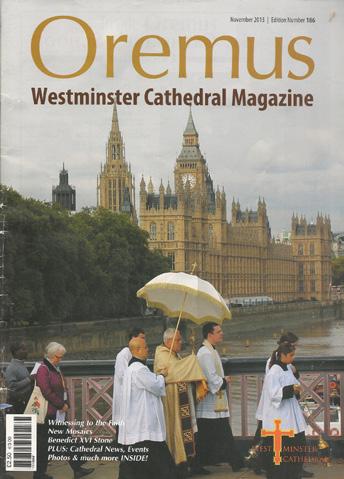
The driving force behind these processions was the well-known Catholic writer and broadcaster, Joanna Bogle DSG. In 1982 Pope St John Paul II made the journey from Westminster to Southwark Cathedral (St George’s) and Pope Benedict went from Westminster to St Peter’s Residence in Vauxhall, run by the Little Sisters of the Poor and returned north of the Thames to Hyde Park where, in the evening a memorable vigil was held, culminating with Benediction of the Blessed Sacrament given by the Pope. Many young people attended this event and had arrived hours beforehand on what was, fortunately, a warm and sunny day.
A concern of the organisers was that disrespect might be shown to the Blessed Sacrament during the procession, However, such fears were allayed and it was remarkable how many people in pubs and cafes en route actually stood as the Blessed Sacrament went by. It is fair to say that when the procession reached St George’s Cathedral for Benediction the Cathedral was well filled by not only those who had undertaken the walk from Westminster, but also those who had been unable to join the procession.
Processions of the Blessed Sacrament usually take place in June around the Solemnity of Corpus Christi, but it will be noted that unusually these particular processions took place in September to mark the anniversary of Pope Benedict XVI’s visit to this country and the beatification of Blessed John Henry Newman in September 2010.
Apart from one year, these commemorative processions went from Westminster to Southwark, the stewarding being undertaken by volunteers from both Cathedrals, including the Knights of St Columba. There was no Metropolitan Police presence, as the organisers had agreed beforehand that the processional route would walk along the pavement with traffic not being held up to allow the procession to cross the various roads; this all had the effect of different groups along the route singing various hymns at the same time, for example, both Sweet Sacrament Divine and the Lourdes hymn could be heard simultaneously and for those who wished to pray the Rosary, there were usually two different mysteries being prayed.
Carrying the monstrance in procession in 2013 was shared between the Cathedral Administrator, Canon Christopher Tuckwell RIP and Fr Alexander Master, then Sub Administrator and Precentor. Carrying the ombrellino was William Loh, who is now a Permanent Deacon in the diocese. Immediately behind in purple is the late Berenice Roetheli, who for many years was a volunteer at the Cathedral. Her many duties, apart from being a proof reader for this magazine, included acting as Assistant Registrar.
Author’s Interview with Joanna Bogle
September 2023
Image: Oremus November 2013
Oremus is available for collection from the Cathedral, can be sent to you by post, read online at the Cathedral website or delivered direct to your inbox
https://westminstercathedral.org.uk/the-cathedral-community/about-oremus/ Email: oremus@westminstercathedral.org.uk

I wish to receive Oremus by post (Please fill out this coupon)
PLEASE COMPLETE IN BLOCK CAPITALS
I enclose a cheque for £ payable to WestminsterCathedralAdministration
I enclose a donation of £
Name:
Address:
Postcode:
For further information please call 020 7798 9052 or email oremus@westminstercathedral.org.uk .
We would like to thank our readers for their continued support and all those who send donations. Increased postal costs for overseas mean that annual subscription rates are UK £28; Europe £58; Rest of the world £75. Send to: Oremus, 42 Francis Street, London SW1P 1QW United Kingdom
A young woman, Gertrude Flanagan, of Chesterton Road, Bayswater, who on July 24 last (i.e. 1922) was bound over in £10 for 12 months’ good behaviour for sending offensive postcards through the post to the Rev Napier Hemy, of the Roman Catholic Cathedral, Westminster, was summoned before Mr Chapman, at the Westminster Police-court yesterday, for a breach of her recognisances.
Mr Francis Hackett, sacristan at the Cathedral, said on Thursday last the defendant, whose voice he recognised and knew well, rang up the Clergy House on the telephone. He spoke to her and she said she wanted to speak to someone who could get rid of Fr Hemy from the Cathedral. Acting on information received, on the afternoon of the following day, he went to Paddington Station and there saw the defendant at a telephone call box. He sent for a police constable, and on his arrival tapped on the glass partition of the call box. Defendant opened the door, and he said: ‘Are you Miss Daphne Jones?’ This was a name she had previously given on the telephone when calling up the Clergy House. She replied that Daphne Jones was not her name, and that she was asking for a Gerrard number. The hall porter was holding the line meantime at the Cathedral, and witness took the receiver from defendant’s hand and gave it to the police constable who had been called in order to show that the Clergy House had been called up. While the constable was speaking, defendant said: ‘This is the first time I have telephoned. I was ringing up the Clergy House. I wanted to get one of the priests to use his influence to get rid of that wretched man Hemy.’ Witness added that in the evening the defendant called upon him and appeared to be somewhat nervous about a summons which she had heard had been issued. He did not satisfy her, and she said, ‘Well, I did telephone four or five times, but not every time.’
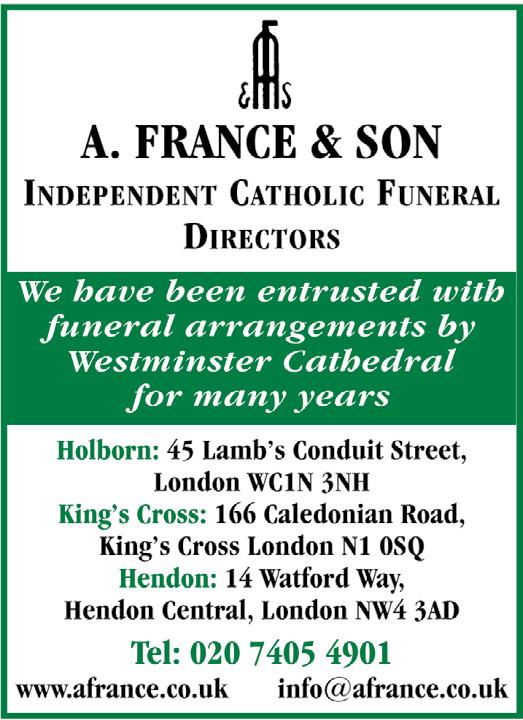
Defendant, told she could question the witness, did not ask anything relevant, and made the observation, ‘All girls’ voices are alike.’ Herbert Pape, hall porter at the Clergy House, said that he had received calls from several places, all in the same voice, and, acting on instructions on Friday last, on receiving a call from a Bakerloo Station, he kept the caller in conversation until the last witness could reach the place. On several occasions the voice, which he now recognised as that of the defendant, referred to Fr Hemy as ‘a wicked old man.’ Once she said: ‘All London is talking about him. Has that wicked old man, Fr Hemy, gone away yet?’ On August 1, a call was received from Daphne Jones, and he recognised the voice as that of a previous caller in the name of Phyllis Jordan. She said she was a member of a London girls’ club, to which hundreds of girls belonged, and they wished to send a petition to Mgr Howlett against ‘this dreadful man, Fr Hemy, whose conduct is indescribable,’ and they wished to have him moved. They also desired to know whether they should present the petition personally, or send it.
On August 2, the same voice rang up again and spoke about a girl university student, Gertrude Flanagan, who had been molested by Fr Hemy jumping up from behind pillars in the Cathedral. She also said there were several charges against him,
including one of slander, and that the president of the girls’ club was taking up the case. Defendant: ‘I was asking to speak to the Administrator, and was told he would speak to me if I would hold on. I held on – for ages.’ The Magistrate: ‘What you have done is again to try to annoy the rev gentleman. You tried to speak to people in authority to try and get rid of him. It is monstrous. You said his conduct was indescribable.’ Defendant: ’This is the first time I have heard that expression, nor have I heard before the expression of a man jumping up from behind a pillar. The hall porter told me to hold on until the Administrator could speak to me.’
Mr Chapman: ‘A very humble lie. The question now is whether you should be convicted on the first offence with which you were charged under the Post Office Act.’ Defendant: ‘If I have made any error at all in asking to speak to the Administrator it was unintentional and I deeply regret it.’
Mr Chapman: ‘You spoke four or five times. That is not to be spoken of as unintentional.’ Mr John Deeks, the clerk of the court before whom defendant was bound over in July last, gave formal evidence to that effect. Mr Chapman, remarking, ‘Now you have repeated the offence,’ fined defendant £10 or six weeks’ imprisonment.
from The Daily Telegraph, 8 August 1923
‘He was humbler yet, even to accepting death, death on a cross’ (Philippians 2:8).
I suspect that the crucifix became a symbol of Christianity only after those who had actually been present and personally witnessed the gruesome and grisly horror of a crucifixion had all died. It also implies that to have willingly undergone this trial for our redemption must mean that we have been saved from something that must be unimaginably worse.
God has given us many examples of how creative he can be and how he can turn evil into good. ‘His blood be upon us and on our children’ (Matthew 27:25). Jesus accepted this curse and changed it into a prayer and gave us the Precious Blood to bring mercy and forgiveness. Rather than the mundane turning of stones into bread to satisfy only an immediate and temporary need, he turned bread into his own body in the Eucharist as an everlasting food for the soul. Why did he choose to redeem mankind by suffering the utter humiliation and degradation of the cross? Despite the creativity that Christ had at his disposal to find other ways of redeeming and saving mankind, he nevertheless chose to redeem us through his cross. He paid a debt he did not owe because we owed a debt we could not pay.
The writings of St Vincent Ferrer (1350 – 1419), a Dominican friar and preacher from Valencia, may throw some light on this. His thesis was that when satisfaction needs to be made for some sin, it is reasonable that that satisfaction corresponds in some way to the sin. For instance, if one sins by mouth by defaming or swearing, one should seek pardon by mouth from God and neighbour. If through the eyes you have sinned by gazing, proper satisfaction is to weep. If you have sinned through your ears by listening about a neighbour, healing is made by hearing Mass and sermons. If you have sinned by hand, extend it in prayer. According to Genesis, the original offence against God was committed by the theft of a certain fruit, contrary to a clearly expressed command. Restitution, reparation, or amends, therefore, ought best to happen by a direct relevance with the tree.

The Golden Legend is a collection of hagiographies by Jacobus de Voragine that was widely read in Europe during the late Middle Ages. One such legend is that Christ’s cross was formed from the wood derived from the Tree of Knowledge of Good and Evil. Legend has it that a cutting from the Tree of Knowledge was taken out of the Garden of Eden and Seth is said to have planted an offshoot from the tree on Adam’s grave.St Jerome was of the opinion that Adam was buried in an area later called Hebron but another legend has it that Adam was buried at Golgotha, hence The Place of the Skull.
Over time, this cutting grew and became a very large tree. It is believed that King Solomon cut it down and used the wood to make a bridge across a pool of water. However, the Queen of Sheeba had a revelation that the Saviour of the world would one day hang upon this wood and refused to set foot on the bridge. She warned King Solomon of her premonition and he, hoping to avert such an evil prophecy, ordered the destruction of that bridge and that the beam be buried in the ground. This was done at the site which later became known as the Pool of Bethesda, whose very healing properties were linked to the presence of the wood of this tree. Shortly before the time of the Passion, the wood came to the surface and was used by the Romans to form the Cross.
This legend was also invoked in Dante’s Divine Comedy: Purgatory. In a stanza of this epic poem, a chariot, which figuratively represented the Church, is drawn by a pole formed of wood from the Tree of Knowledge, thus joining the instrument of the Fall with the Instrument of Redemption. All this is, of course, legendary and speculative. It is not in any way part of the deposit of Faith.
Although Christ had other ways of redeeming us, nevertheless, when seen in context, his way – through the cross – was appropriate, and shows how possibly the satisfaction was directly linked to the initial offence. Christ decreed that man would be saved through the wood of the cross. It is, however, interesting to speculate on the possibility that it might be a celestial masterstroke that the tree of man’s defeat was itself used by Christ and transformed by him to become the Tree of Victory: the ultimate example of how evil can be turned to good.
Sr Ruth Evans
The Temple candelabra stood some fifty cubits high.
The crowd were caught in praise and awe before God’s majesty.
As flares of huge, uplifted flame travelled the autumn sky, leapt gold across the harvest night, illumining Jerusalem.
Their faces were obscure and taut, recoiled before the carpenter. It was not clear what plan they had, though certainly not sympathy for one who gently claimed to be, the Light of God. Life held out with authority for all who travelled in the dark. He had no evidence, they said, and they all knew where he was from. The Father he relied upon, manifestly was not there, leaving him with one witness, himself, which bore no weight in law. The uninstructed would be told, to disregard his words. (They watched him all the while, as if they had in mind a trial.)
The Northerner stood solitary, and unperceived, a Nazarene from Galilee, sentenced apart, light not received, faithful to a faith disowned, a Father that they had not known, watched them forsake his promises. And leave him to await the fate of one whose hands are tied at night, whose blasphemy is not believed, one whom the law does not defend. Left on his own to contemplate a road outside Jerusalem, his face was worn by travelling and bitten by the wind.
The Feast of Tabernacles was celebrated in Jerusalem. All adult male Jews living within 15 miles of Jerusalem were obliged to attend and it is recorded in the Gospel of John that Jesus travelled to the feast. The people moved into temporary, makeshift shelters to remind them of their time wandering in the desert. The feast of Tabernacles was joyful and celebrated God’s gift of the Autumn harvest. At night four massive torches illuminated the Temple so that the Temple precincts were bathed by the intense light. This was a thanksgiving to God as the light of his people. During the feast Jesus cried out that he was the light of the world. This year the Feast is celebrated from 29 September to 6 October.
To submit a poem whether by yourself or another for consideration, please contact the Editor – details on page 3.
Clues Across
1 Diocese where Cardinal Vaughan was earlier the Bishop (7)
6 & 14 Down: Vintage champagne named after a Benedictine monk (3,8)
8 Major artery of the human body (5)
9 Hereditary honour and title, though not part of peerage (7)
10 Position for a bronze medal (5)
11 Spur of the moment witticisms or dialogue improvisations (2,4)
13 Saint and one of the twelve Apostles (6)
15 Terrain where Jesus fasted for 40 days and nights (6)
17 Book of the Old Testament (6)
20 Heavenly food that sustained the Israelites in the 15 Down (5)
21 ‘Full in the ------- heart of Rome’, opening of the hymn by Cardinal Wiseman (7)
23 Papal crown (5)
24 Constricting type of snake (3)
25 Element among the rare gases of the atmosphere (7)
Clues Down
1 From which a Crusader would draw his sword (8)
2 Type of wreath at Christmas or funerals (6)
3 Nicholas ----, brilliant craftsman, one of the 40 Martyrs (4)
4 Poet, famously associated with his ‘Inferno’ (5)
5 Walking supports, many once placed in Lourdes grotto, indicating the cures there (8)
6 Book of the OT, wherein Belshazzar sees ‘the writing on the wall’ (6)
7 ‘---- of Orleans’, reference to St Joan of Arc (4)
12 Saint who accompanied and preached with St Paul on his mission (8)
14 See 6 Across

16 ‘------ Maria, Mater Dei’, ‘Holy Mary, Mother of God’ (6)
18 Vertical measurement of person or building (6)
19 ‘Nation shall ----- peace unto nation’, motto of the BBC (5)
20 Biblical kingdom of the Levant where Moses died (4)
22 A shade of blue, favoured by sailors? (4)
From the trial speech of St Edmund Campion: (1581)

‘In condemning us you condemn all your own ancestors – all the ancient priests, bishops and kings -all what was once the glory of England, the island of Saints, and the most devoted child of the See of Peter. For what have we taught, however you may qualify it with the odious name of treason, that they did not uniformly teach? To be condemned with these old lights – not of England only, but of the world – by their degenerate descendants is both gladness and glory to us. God lives: posterity will live: their judgment is not so liable to corruption as that of those who are now going to sentence us to death.’
The Holy Father’s Prayer Intention: For the Synod
We pray for the Church; that she may adopt listening and dialogue as a lifestyle at every level, and allow herself to be guided by the Holy Spirit towards the peripheries of the world.
Sunday 1 October Ps Week 2
27th SUNDAY IN ORDINARY TIME
Annual Mass Count – Week 3
12 noon Solemn Mass (Full Choir)
Tye – Missa Euge bone
Palestrina – Super flumina Babylonis
Organ – Allegro mæstoso (Symphonie III)
– Vierne
4pm Solemn Vespers with Induction of Choristers and Benediction
Marenzio – Magnificat octavi toni
Holst – Nunc dimittis
Organ: Organ Solo (Glagolitic Mass) –Janáèek
4.30pm Deaf Service Mass in Cathedral Hall
Monday 2 October
Holy Guardian Angels
10.30am The Red Mass, to mark the beginning of the Legal Year (Bishop Sherrington)
Tuesday 3 October
Feria
4.45pm Chapter Vespers with Installation of Canons
5.30pm Chapter Mass
Wednesday 4 October
St Francis of Assisi
1.15pm Lunchtime Concert
5.30pm St Francis Leprosy Guild attends Mass (Bishop Moger)
Thursday 5 October
Feria (St Faustina Kowalska, Virgin)
5.30pm Association of Papal Orders attends Mass (Archbishop Longley)
Friday 6 October Friday abstinence
Feria (St Bruno, Priest)
* Harvest Fast Day
The Cathedral is open from 7.30am and closes in time for 7pm.
Monday to Friday: Morning Prayer 7.35am, Mass 8am, Mass (Latin, unless there is a Funeral) 10.30am, Confessions 11.30-12.30pm, Mass 12.30pm *, Exposition of the Blessed Sacrament 1.15-4.30pm, Benediction 4.30pm, Confessions 4.30-5.30pm, Sung Vespers 5pm (Latin, Choir, except Tuesday, English, Cantor), Solemn Mass 5.30pm (Choir, Tuesday: Boys’ voices, Wednesday: Men’s voices).
Saturday: Morning Prayer 7.35am, Mass 8am, Mass 10.30am (Latin, Choir), Confessions 11.30-12.30pm, Mass 12.30pm *, Confessions 5-6pm, Sung Vespers 5.30pm (English, Cantor), Sung Mass 6pm.
Sunday: Mass 8am, Sung Morning Prayer 9.30am, Sung Mass 10am, Confessions 10-12.30pm; Solemn Mass (Choir) 12noon *, Solemn Vespers and Benediction (Choir) 4pm, Confessions 5-6.45pm, Sung Mass 5.30pm, Mass 7pm.
For full opening and closure times of the Cathedral and for confession and service times, please consult the Cathedral diary on the website.
* Live streamed via the Cathedral website
Monday 9 October
St JOHN HENRY NEWMAN, Priest
Tuesday 10 October
Feria
(St Paulinus of York, Bishop; St Denis, Bishop, and Companions, Martyrs; St John Leonardi, Priest)
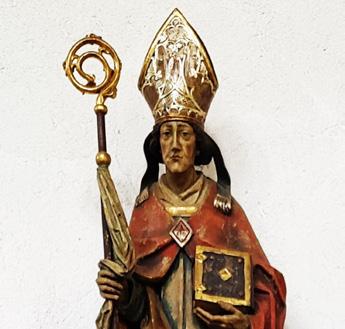
5.30pm PACT attends Mass (Bishop McAleenan)
Wednesday 11 October
Feria
(St John XXIII, Pope)
1.15pm Lunchtime Concert
Thursday 12 October
Saturday 7 October
Our Lady of the Rosary
2.30pm Mass for Westminster Altar Servers (Bishop McAleenan)
4pm Low Mass (Blessed Sacrament Chapel)
Sunday 8 October Ps Week 3
27th SUNDAY IN ORDINARY TIME
Annual Mass Count – Week 4
* Week of Prayer for Prisoners and their Families
12 noon Solemn Mass (Full Choir)
Byrd – Mass for five voices
Palestrina – Vir erat in terra
Organ – Prelude in B minor (BWV 544) –J.S. Bach
4pm Solemn Vespers and Benediction
Bevan – Magnificat sextii toni
Byrd – Tribue Domine
Organ: Fugue in B minor (BWV 544) –J.S. Bach
Feria
(St Wilfrid, Bishop)
5pm Joint Evensong at Westminster Abbey (Cathedral: 5pm Said Vespers and 5.30pm Said Vigil Mass of St Edward)

Friday 13 October No Friday abstinence
ST EDWARD THE CONFESSOR, Patron of the Diocese and of the City of Westminster
5pm Solemn Second Vespers
5.30pm Solemn Mass (Full Choir)
Berkeley – Missa brevis
Byrd – Gaudeamus omnes
Byrd – Ave verum corpus
Organ: Finale (Sonata in G) - Elgar
Saturday 14 October
Blessed Virgin Mary on Saturday (St Callistus I, Pope & Martyr)

6pm Cathedral Junior Voices sing at Mass
Sunday 15 October Ps Week 4
28th SUNDAY IN ORDINARY TIME
12 noon Solemn Mass (Men’s voices)
Lassus – Missa Triste départ
Palestrina – Cantabo Domino
Palestrina – Deficiant peccatores
Organ: Præludium in E minor – Bruhns
4pm Solemn Vespers and Benediction
Victoria – Magnificat tertii toni
Byrd – Laudate Dominum
Organ: L’ange aux parfums (Les Corps
Glorieux) – Messiaen
Monday 16 October
Feria
Tuesday 17 October
St Ignatius of Antioch. Bishop & Martyr
Wednesday 18 October
St LUKE, Evangelist 1.15pm Lunchtime Concert
Thursday 19 October
Feria
(Ss John de Brébeuf and Isaac Jogues, Priests, and Companions, Martyrs; St Paul of the Cross, Priest)
2.30pm Memorial Mass, Baroness Masham of Ilton RIP (Cardinal Nichols)
Friday 20 October Friday abstinence
Feria
Saturday 21 October
Blessed Virgin Mary on Saturday
Sunday 22 October Ps Week 1
29th SUNDAY IN ORDINARY TIME
* World Mission Day
12 noon Solemn Mass (Men’s Voices)
A. Gabrieli – Missa Pater peccavi
Palestrina – Meditabor in mandatis tuis Guerrero – O sacrum convivium
Organ: Allegro (Symphonie II) – Vierne
4pm Solemn Vespers and Benediction de Monte – Magnificat primi toni
Cavalli – Salve Regina
Organ: Toccata in D minor (BWV 538) –J.S. Bach
Monday 23 October
Feria
(St John of Capistrano, Priest)
Tuesday 24 October
(St Anthony Mary Claret, Bishop)
Wednesday 25 October
Feria
1.15pm Lunchtime Concert
Thursday 26 October
Feria
(Ss Chad and Cedd, Bishops)
Friday 27 October Friday abstinence
Feria
Saturday 28 October
Ss SIMON and JUDE, Apostles
9.30am – 4.30pm A Day with Mary
6pm Visiting Choir
Sunday 29 October Ps Week 2
30th SUNDAY IN ORDINARY TIME
12 noon Solemn Mass (Men’s Voices)
Byrd – Mass for four voices
Byrd – Diliges Dominum
Organ: Toccata (Symphonie II) – Dupré
4pm Solemn Vespers and Benediction
Bevan – Magnificat octavi toni
Howells – Salve Regina
Organ: Concerto in C major (BWV 594) –J.S. Bach
Monday 30 October
Feria
Tuesday 31 October
5.30pm Vigil Mass of All Saints – fulfils
Holyday Obligation
Key to the Diary: Saints’ days and holy days written in BOLD CAPITAL LETTERS denote Sundays and Solemnities, CAPITAL LETTERS denote Feasts, and those not in capitals denote Memorials, whether optional or otherwise. Memorials in brackets are not celebrated liturgically.
Catholic Grandparents’ Association
Hinsley Room,
Second Sundays 12-3.30pm
Charismatic Prayer Group
Cathedral Hall, Fridays 6.30-9pm
Divine Mercy Prayer Group
St Patrick’s Chapel, Sundays 1.30-2.30pm
Filipino Club
Hinsley Room, First Sundays 1-5pm
Guild of the Blessed Sacrament
Blessed Sacrament Chapel, Mondays 6.15pm
Guild of St Anthony Lady Chapel, Tuesdays 6.15pm
Interfaith Group Hinsley Room, Third Wednesdays 2-3.30pm
Legion of Mary
Hinsley Room, Monday 1.30-3.30pm
Nigerian Catholic Association
Hinsley Room,
Fourth Sundays – 1.30-2.30pm
Oblates of Westminster Cathedral
Hinsley Room,
Fourth Sundays 2.30-4pm
Padre Pio Prayer Group
Sacred Heart Church, First Thursdays 1.30-3.30pm
RCIA Group
Vaughan House, Tuesday 7-8.30pm
Rosary Group
Lady Chapel, Saturday 10-10.25am
Walsingham Prayer Group
St George’s Chapel, First Tuesdays 2.30-4pm
Yoruba Association
Hinsley Room, Third Sundays 1.30-3pm
The great interest awakened by the Organ Recitals in the Cathedral has led to a request being made by the British Broadcasting Company for permission to broadcast one of them, and it has been arranged to broadcast the recital to be given on Thursday, 1 November. All interested in the progress of the Grand Organ will be glad to hear that the Contra Trombone stop (20 from 75), which was put in temporarily for the benefit of Monsieur Marcel Dupré, has been added permanently to the organ, as the necessary money has been found for this further addition. It will be seen, however, from the printed programmes given out at each recital, that much remains to be added and paid for before the Grand Organ is complete as designed. Dupré had a significant hand in the design of the Grand Organ, inaugurating it and presenting here the world première of his Symphonie Passion in October 2024.
from the October 1923 Westminster Cathedral Chronicle
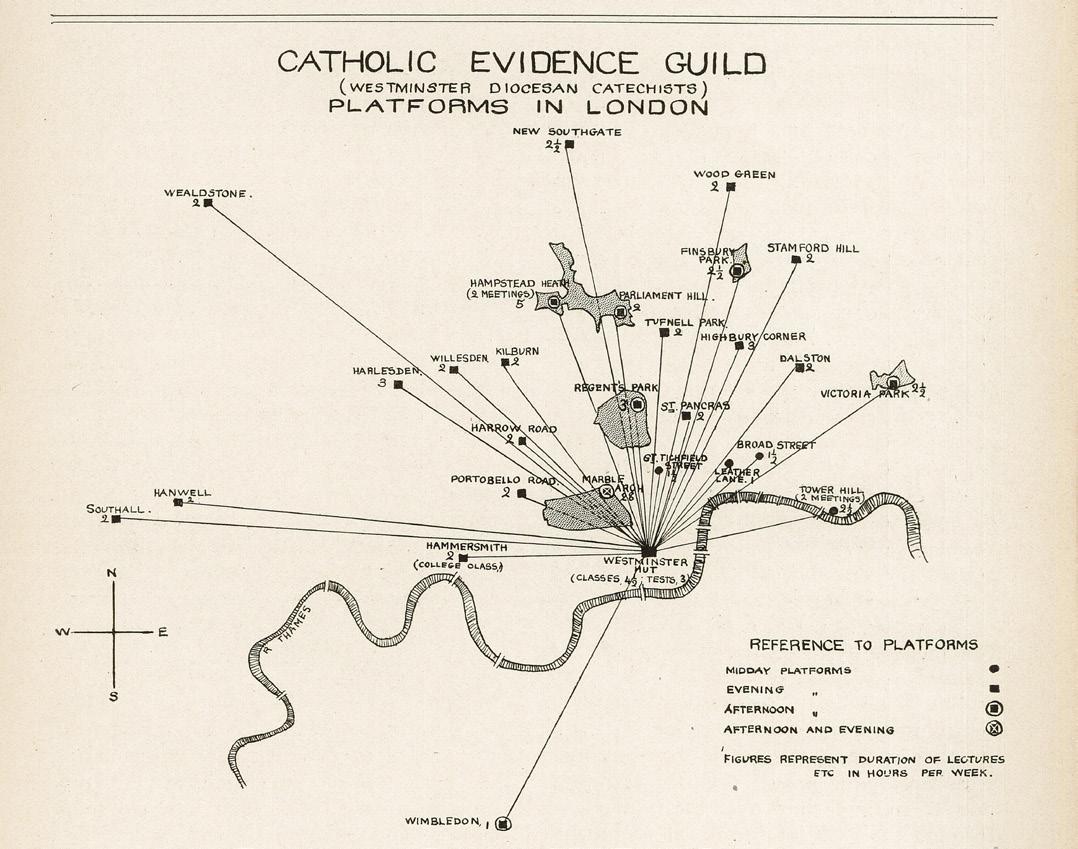
The importance of Westminster Cathedral cannot be understated. It is significant in the ecclesiastical hierarchy with its designation as the Mother Church of England and Wales. Moreover, it is a place of constant worship, a building of ‘living stones’, with the words of the psalms, the example of the saints, and the celebration and conferral of the sacraments ever at its heart. As such, it is of the utmost importance that we care for the Cathedral, honouring the roles it plays in the life of the Church.
Aside from that, the current time should help us understand better the importance of our work. Seen alone, your fees for events, membership, and fundraising may be modest. However, the Cathedral is so very grateful for them, for the support which it represents, and for the huge sums which are generated between the membership as a whole; all our activity at The Friends is ordered towards the preservation of the Cathedral in a way which keeps the sacrality of worship and the dignity of the sacramental life front and centre.
Do you want to be kept in close contact with news and opportunities to contribute to our mission of caring for the Cathedral? Head to the Cathedral website to sign up for membership or contact friends@rcdow.org.uk
Booking for events can be done by emailing friends@rcdow. org.uk, visiting our website https://westminstercathedral. org.uk/the-cathedral-community/the-society-of-friends-ofwestminster-cathedral/or writing to Clergy House. Payment is available with cash, cheque, or card.

Tuesday 17 October, Refreshments from 1:30pm, Event 2:00-3:30pm in Clergy House Library.
Adrian Waddingham will introduce his recent book Breakspear: The English Pope (The History Press, 2022), with time for Q&A, book purchase and signing. Tickets, £5, in advance and on the door. Entry will be via the Lady Chapel, with stewards on hand to direct you.
In recent months, our care for the Cathedral has been manifested in the lighting scheme with the pledge of £300,000 for the illumination of the sanctuary. As this chapter comes towards fruition and a successful close, what comes to mind is that the care of the fabric as a fitting venue for the celebration of the liturgy is a continual task. Existing features require maintenance, and new features are needed, with the various steps of scoping, seeking permission, and raising all-important funds amounting to a marathon not a sprint. Some stages of this marathon are difficult; the finish line can feel like worlds away. But the present moment brings a feeling of excitement – the finish line being so close. Indeed, we have now raised in timely fashion £220,000 of the £300,000 pledged for the new sanctuary lighting – the fruit of hard work and generosity of The Friends. As we progress closer to our total pledge amount, we see the impact of our fundraising in real time. On the strategic level, we estimate ourselves to be just one campaign away from raising the balance. Meanwhile, since Easter, the new lighting has allowed us to experience the liturgy in a more focused way at a significantly reduced cost. Where does this leave us? Principally, in relation to our current lighting project, the 2023 Big Give will run from Tuesday 28 November to Tuesday 5 December. Last year we raised an incredible £70,000; this year, we are hoping to match and exceed this, and more information will be available in next month’s Oremus. One final push and this particular marathon will be complete.

Wednesday 25 October, 6pm for 6:30pm start. Venue: Cathedral Hall.
QUIZ NIGHT with FISH & CHIP SUPPER . The return of this popular event, with six rounds of competition and fellowship. Fr John Scott is quizmaster. Tickets £20, with advance booking essential.
Friday 27 October, 3pm.
ST JOHN HENRY NEWMAN WALKING TOUR
Acclaimed guide and writer Joanna Bogle will lead us through the City of London as we explore key sights associated with our newest English saint.
Tickets £10, available in advance or on the day. We will meet on the steps of St Paul’s Cathedral.
Tuesday 28 November to Tuesday 5 December
THE BIG GIVE 2023. Our annual fundraising campaign will this year seek to raise the balance for the amount we have pledged for the sanctuary lighting. Keep an eye out in Cathedral communications for more information on how to donate.
The Friends are constantly seeking out and organising exciting and varied events. Keep an eye out in next month’s Oremus and the usual channels for information on a new series of talks, and how we will be marking Advent and Christmas this year.
